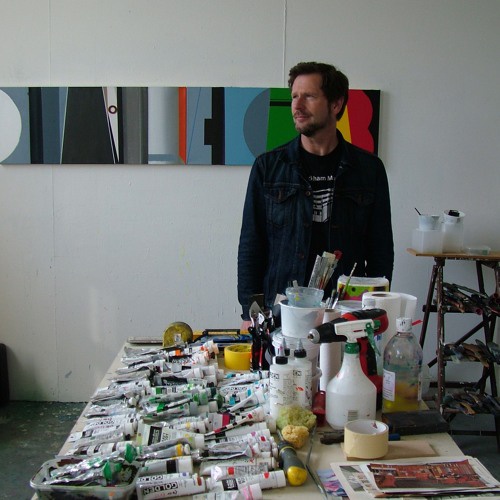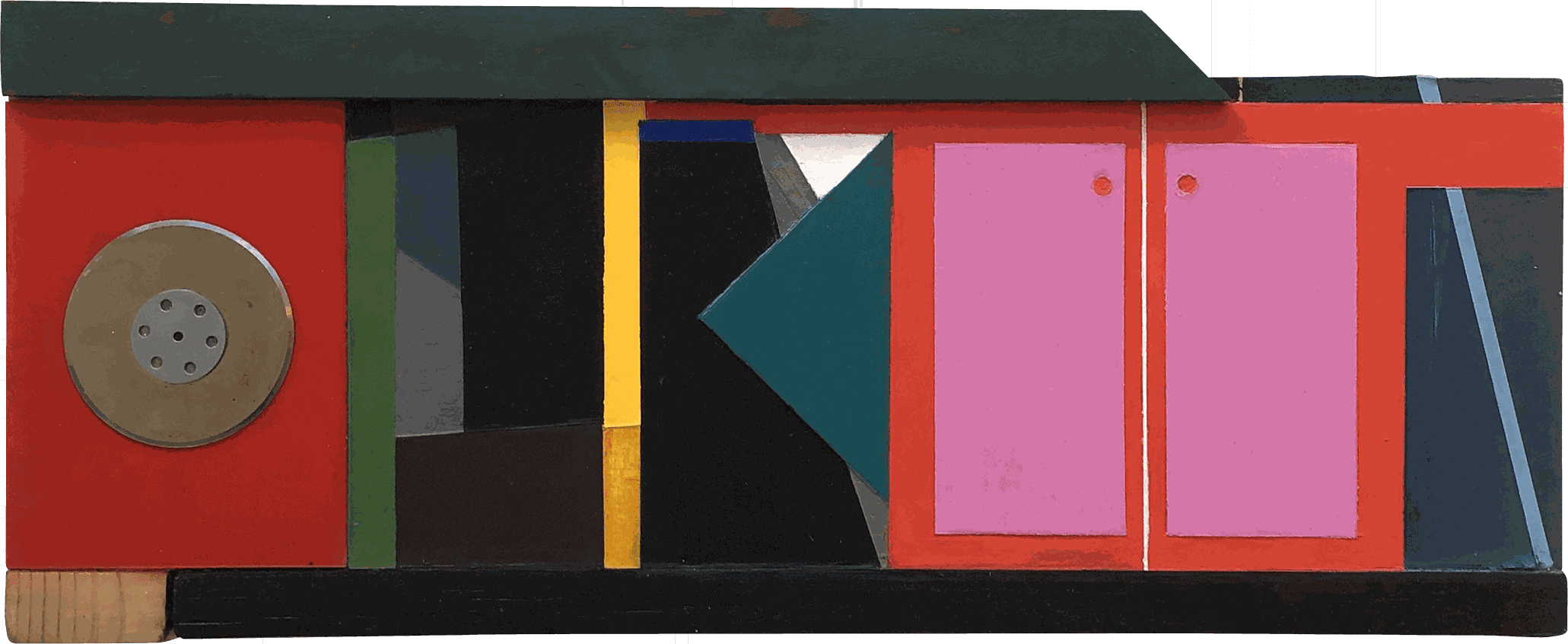

Laurence Noga at his studio
Poetics of Obsolescence
Slivers of forms trimmed to leave arcs and floating discs. Fat blocks and terse diagonals. A triangle, red or black, juts out from the construction, breaking a frame. Papered segments, painted segments. An unpainted wooden rod.
Embedded amongst the profusion of shapes are reminders of abandoned utility – a steel handle, a metal disc, a used ticket, part of a rusty tool, a faceless LP, an old washer. Nameless, obsolete utility. Bits of plastic and metal that, now stripped of function and context, lace the landscapes of geometry with rootless nostalgia.
These found signs without provenance function as humble, anachronic portals to other times. Collected from the artist’s father’s garage, they are fragmented mementos revealing the constructions as stratigraphic layerings of time. Vestiges of things that may once have moved but are now arrested, of anonymous processes and operative systems no longer in use, they reveal the obsolete as registration of the cessation of time’s continuity. Assemblage is activated as the debris of outdated signs, and the stratification of material layerings that embed time in the hybrid object.
The complex action of strips and discs play a further crucial role in this. Amongst the rich lexicon of shapes employed by Noga, they assume a special function – to interrupt the passage of lines and colour. Discs and strips force discontinuity into the otherwise incessant rhythms and modulations. Introducing a stop-start effect, they intensify the temporal dynamics introduced by the symbolic dimension of the rootless signs. Indeed, it is because of this interweaving of the symbolic and the formal, the way the real objects are simultaneously invested as conduits of the compositional currents, that we are never permitted to cross the threshold into the referential.
In Deep Red filtered pink, the large red disc, a painted cd, dimly evokes an experience (sonic) now over. A visual stoppage, it also acts a bullseye that pulls our gaze to its centre, momentarily halting the eye’s passage across the polychromatic surfaces. The disc is echoed by a cluster of smaller circles and orbs of metal screws, countering the dominant, directional presence of the black triangle. A broad pink strip halts the chromatic motions. Double yellow filtered black consists of a nuanced interplay of discs and strips: the uppermost row of holes, the embedded redundant disc-objects in the central band, and the cluster of cadmium red spots half-concealed within an imposing matte border of black strips. In the wide ‘band’ paintings, segments of rings edge their way into the lateral sequence of shapes; monochromatic strips are more forceful breakages of this continuity from left to right.
Experiencing this collection of constructions as a play of discontinuous eruptions reminds me of Gaston Bachelard’s meditations on time in his 1932 Intuition of the Instant. Bachelard theorised the instant as a discontinuity in the temporal continuum, a creative rupture that renders time poetic. An expression of ‘vertical time’ that cuts the horizontality of clock time, the instant is a burst of consciousness, both sudden and surprising, that calls for an acute act of attention. In its contrast to theories of the instant that associate it with the instantaneous and simultaneous temporality of technologically-mediated experience, Bachelard’s viewpoint offers an intriguing framework for further reflecting on the sense of Noga’s constructions. We are invited to consider the power of anachronic symbols and gestures as creative events, disturbing the routine experience of the present with the intensification of perceptions.
~ Kamini Vellodi, May 2021
Dr Kamini Vellodi is a writer and artist and Director of Research, Senior Lecturer in Philosophy, Theory and History of Art in Edinburgh College of Art at the University of Edinburgh. Her research intersects 20th century and contemporary continental philosophy and theory, and theories and historiographies of art history and visual culture. She is the author of 'Tintoretto's Difference. Deleuze, Diagrammatics and Art History' published by Bloomsbury in 2019, and is Series Editor of 'Refractions. At the borders of art history and philosophy' for Edinburgh University Press. She studied Painting at the Royal College of Art and Chelsea College of Art and holds a PhD in Philosophy from the Centre for Research in Modern European Philosophy, Middlesex University.
Exhibition curated by Vivienne Roberts

